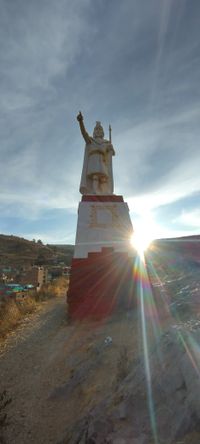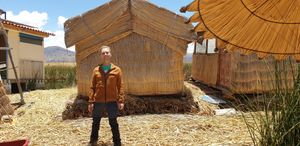18 days after we left Perú, on 7th December, President Pedro Castillo moved to dissolve Congress in his country, a Congress which was about to take a vote on his removal due to corruption charges. Almost immediately, Congress did vote to remove him, as a result of the dissolution, and he was arrested by the Peruvian National Police. He was replaced, as per the country’s constitution, by his vice-president Dina Boluarte, who denounced Castillo on taking office.
Castillo’s detractors say he was attempting a self-coup in taking charge of the country’s democratic institutions – and Perú has hard experience of self-coups, military coups and dictatorships.
His supporters, (including the governments of Mexico, Bolivia, Argentina and Colombia), claim that economic and political elites were obstructing and maintaining an environment of confrontation and hostility against him, being threatened by his progressive left-wing policies; and that he was backed into an impossible corner by these and a hostile right-wing press.
It is so sad to see the effects of this on these places we visited so recently – and to imagine how the situation will be affecting the lives of the warm, welcoming and gentle people we met there. And it’s tragic to consider the 48 people who have been killed, and the hundreds injured, by police and security forces brutally suppressing the large protests now taking place.
***

From incredible Cusco, we bussed east towards Lake Titicaca, through the region now at the centre of the protests and blockades. In the lakeside town of Puno we stopped. The town spills down the valleys to the lake, where a harbour holds a fleet of small white boats, along with a larger, riveted steel steamer – on looking this up, I learn that the ‘Ollanta’ was built on the Humber in 1929, disassembled, shipped to Perú and transported over the Andes by rail. Her predecessor, the ‘Yavari’ was constructed in England in a similar way in the 1860s - but back then, the packages of iron plate, rivets, boiler and machinery parts were broken down into 160kg packages to be transported to Titicaca at 3,800m above sea-level by pack mules.

Ss Olanta in Puno Harbour
I climbed to the large Inca statue that overlooks Puno and this western corner of the lake.  The town extended beneath me looking like a Kodachrome panorama, with red roofs, buildings brown and white, and the cyan lake, surrounded by yellow reeds and grassy hills. The sun had not quite set, so I climbed higher, despite the thin air and the slight temple headache that never seemed to leave me while at altitude, reaching the large condor statue for the wider view.
The town extended beneath me looking like a Kodachrome panorama, with red roofs, buildings brown and white, and the cyan lake, surrounded by yellow reeds and grassy hills. The sun had not quite set, so I climbed higher, despite the thin air and the slight temple headache that never seemed to leave me while at altitude, reaching the large condor statue for the wider view.

Puno viewed from the giant Condor on the hillside
***
I had read of the Uros people and their floating islands, moored out in the lake.
Keen to see something of these, we had arranged to spend a night on one; so we were instructed to be at Puerto Kalapajra at 1200, and to wait for Nestor, who would pick us up. The pace of life slowed immediately when we arrived at this tiny pier among the reeds – small boats came and went, heavily skirted women loaded small boxes out of taxis, people stopped to chat with others.
The pace of life slowed immediately when we arrived at this tiny pier among the reeds – small boats came and went, heavily skirted women loaded small boxes out of taxis, people stopped to chat with others.
A blue fibreglass open boat appeared, a man in a bright textile waistcoat and straw hat grinned and motioned us over. This was Nestor!

He piloted us through the reeds, a channel wide enough for one small boat, stopping occasionally to clear the outboard propeller of weeds,a nd slowed as the water opened out, showing us the football field – on the mainland – where the islanders gather for a game once a week, and the clinic where once a week a doctor holds a surgery. On our starboard side was the first floating island we would see – a yellow thatch of reeds forming a metre-high island, with a hut, a shoulder-high sign reading ‘UROS’, and a lady in bright textile dress and bowler hat ready to receive the minimal fee charged to visit the islands. 
My Kodachrome sensation continued as we motored out into the greenish-blue lake, the line of islands ahead growing closer in vivid yellows. Occasionally we passed a reed boat under construction – bundles of totara bound together with the raised stems that remind me vividly of the process described in Thor Heyerdahl’s ‘Ra Expedition’. Nestor eased the engine so he could hear my question – and answered that yes, the tradition continued and every islander still learns to make boats this way.
“But the ‘Mercedes Benz’” – he indicated towards a larger boat, still with the traditional appearance and shape, but painted an even brighter vintage yellow, with cat heads woven into the stems and a covered platform built on the midships area – “we make a different way”.

The boats know by the islanders as 'Mercedes Benz' alongside the islands
“We use empty plastic bottles”, he explained. “Five thousand per ‘Mercedes Benz’. The reeds are woven only on the outside so they look the same. And the yellow paint is necessary to keep the reeds from rotting – without paint, the boat only lasts two years. But when we do rebuild, we re-use the bottles... “
I looked around and saw one of these ‘Mercedes Benz’ boats tied alongside every island; this is at least an inventive way to make use of a modern-day waste product, and to perhaps help locally to slow the plastic litter problem that is now choking our whole planet.
Each island appeared to be about 40 metres in diameter, with a dozen or so huts, some two-story wood frame buildings, and a central tower with water tank atop. Each island sports a huge condor, a wading bird, a large arch, or similar centrepiece, all woven and bound from reeds. The islands are arranged nose to tail, almost appearing connected; Another line of islands lined the horizon half a mile further out into the lake.
The islands are arranged nose to tail, almost appearing connected; Another line of islands lined the horizon half a mile further out into the lake.
Arriving at our island, Nestor put the boat alongside the metre-high patch of reeds, we tied up and climbed ‘ashore’. The reeds are spongy underfoot, making walking a little more laborious than usual. “We lay down a fresh top layer every two weeks”, Nestor explained. “But underneath, the island is made from blocks of a different reed; these last thirty years or more. They are moored to those poles - ” I saw a large tree-branch stuck into the lake-bed where he indicated. The smells of the reeds fill the air with a pleasant, citrus/fresh hay odor that islanders must miss terribly when away from home.

Fully traditional reed boats are still built and maintained on the islands
The Peruvian government in the early 2000s provided a solar panel/battery system to each island, so each hut has electric lighting, and each island has hot water and refrigeration. Repairs and construction are done as a community, with about 30 inhabitants on each island pulling together to carry out necessary work. Children go to primary school on the islands – either to the Catholic school or ghe seventh day adventist school. For high school they go across to Puno where they lodge during the week, returning to the islands at the weekends.

Exploring our island
On our island we relaxed, eating lunch (a muddy-tasting trout, of the the same enormous portion size we’ve found all across Perú), chatting to the other islanders (they are Aymara speakers, but speak Spanish as well); and strolling round the island (which takes about five minutes). After a run in the boat with Nestor, taking us down the chain of islands, we headed back to our hut once darkness fell. The violet sunset faded to stars behind the mountains, and the lights of Puno twinkled through the large windows of our hut.

The sun beat down again the next morning, and we spent our time chatting with the neighbours, Annabella and Jorge, who were passing a pleasant morning in the shade outside their huts. “we prefer it here, very much”, Jorge told me. “in Puno it’s all ‘plata, plata, plata’” (money, money, money).

Soon, we were on our way back to the mainland with all its hills, neutral spaces, plata, anonymity and noise; and organised our bus ticket to La Paz, Bolivia. We crossed the border at the lakeside town of Khasani the following day.
***
I messaged our friend Josefina in Ica, South Perú, yesterday, asking how things are now in her region. She tells me that, thanks to God, everything is fine at work and in the city; there were many riots but things are calm at the moment, and people are hoping for a speedy recovery. Peruvians are nothing if not copers, and are grimly used to political upheaval.
They, like we, must survive despite the actions of our leaders and hope the fish will keep biting, the travellers will keep coming, the seasons will be kind, and that politics and violence will not disrupt our best-laid plans!
Till next time...
Barry

